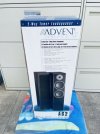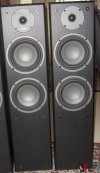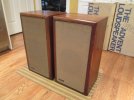Kloss never stuck around long, in any place. He was said to have a pretty 'strong' personality, and therefore, difficult to work with, but OK if you did what he told you to do and didn't complain. That is often a common trait among entrepreneurs. Villchur once quipped that the problem between Kloss and himself was that a company can't have two presidents, and Henry needed his own company, for that reason. It didn't matter much, because Ed had men like Roy Allison in the lab. By the time Teledyne took over, it was pretty much over. Everyone moved on.
Perhaps he had a "strong" personality. The last paragraph of this obit from Tomlinson Holman gives some insight of perhaps another side of this personality in the last paragraph:
A Notable Passing: Henry Kloss
By Tomlinson Holman
Maybe you noticed the recent passing of Henry Kloss, since it was an event covered
by the New York Times (February 5, 2002) obituaries, and by National Public Radio, a
downloadable audio version of which is archived at
http://search1.npr.org/opt/ collections/
torched/atc/data_atc/seg_137575.htm. But then again, for younger people in the
business, and for those with no connection to the consumer side of things, maybe you
don’t even know who he was.
Henry Kloss probably had more to do with how sound is heard in the home, and how
pictures are made for a certain level of home theater, than just about anyone. As a
24-year-old in 1954, he did most of the production work on the first acoustic suspension
woofer/box combination, the AR-1, following the theory of his instructor Edgar
Villchur. Henry was already in the loudspeaker business, and he saw real market possibilities
in this invention, and he and Villchur capitalized the company to exploit the
idea. Using the air in a sealed box as a spring relieved the loudspeaker from doing
this duty, and as the air was a more linear spring than the mechanical suspension of a
loudspeaker, there was lower distortion than prior designs. It also solved the problem
of “big bass from a small box,” and the acoustic suspension (or sealed box as it is
perhaps more commonly called today) became the stalwart of the industry.
“What really caught the public fancy, however, was the fact that the original Acoustic
Research AR-1 was a small loudspeaker system having essentially flat low-frequency
response down into the 40-Hz region. Other manufacturers were quick to point out
that the AR-1 gobbled up about 10 times the electrical power needed by larger, more
efficient systems. With 40- and 50-watt amplifiers becoming available, this turned out
not to be a major drawback, and the trend toward smaller, less-efficient home loudspeaker
systems was firmly established.
It wasn’t until 1960s, when Neville Thiele started making sense of those electromechanical
analogies in Beranek’s book, Acoustics (coincidentally published in 1954),
that the vented box was properly quantified. It took years, and Richard Small’s work
also, for ported enclosures to come into common usage by the late 1970s. Today’s
loudspeakers having dynamic drivers in boxes have to be said to owe the most credit
to Villchur, Kloss, Thiele, and Small.
Henry left AR and formed KLH with partners in 1957. It was here that he ventured into
other audio systems, such as a high-quality table radio and those three-piece systems
having a record player and electronics in one box and two loudspeakers, all in a suitcase
arrangement, that zillions of people took away to college or on vacation. In loudspeaker
design, he supported Arthur Janszen in making full-range electrostatics, the
KLH Model 9, as well as making the best-selling bookshelf loudspeaker of the 1960s,
the Model 6. To push the theory of loudspeaker design, he experimented with making
a loudspeaker with flat power response (100-percent dispersion of flat response in all
directions), and discovered that this design was hideously bright on program material
— another nice theoretical construct hung up on the grounds that it simply didn’t work
in the real world.
Moving to Advent after “L” and “H” bailed on him, he heard the first LP that used
Dolby A noise reduction on the master tapes, and was so impressed with its dramatic
decrease in tape noise that he tracked down Ray Dolby on the phone — in half an
hour — and went to see him the next afternoon in London — to talk Ray into making
a consumer version of the system to fix the plague of low-speed tape recording, tape
hiss. Applying noise reduction first to a KLH open-reel deck, which he built at Advent
for KLH, was the introduction of Dolby B to the world.
The logical successor to the KLH 6 was the Advent Loudspeaker. This best-selling
model of the 1970s combined quality and reasonable price. One of the ways that the
price was kept so reasonable was by doing quite a bit of the process of making the
speaker components in-house. For instance, a slurry was made basically by putting
grocery bags into a Waring blender with water and chopping them up to the right consistency,
then sucking on the mass through a filter to produce a limp cone, then
pressing the cone shape, then finally treating the paper cone with orange bulb dye
from the hardware store to stiffen it and make it less porous. The cone-shaping dye
gives a measure of how good Henry’s seat-of-the-pants design engineering was. Here
a male and female part mate with the cone trapped between them under pressure.
The exact cone shape is determined here, and it is a non-conventional central dome
centered within a larger radius annular ring, a kind of top half of a donut sawn through
sideways. The idea was that, as frequency goes up and cone losses become greater,
the area of radiation shrinks to that nearby the voice coil, maintaining dispersion. On
the other hand, the relatively large overall diameter provided good low-end (for a
tweeter) response and power handling. Really a brilliant piece.
More brilliant than we knew. After hundreds of thousands of these things had been
stamped out, and the original drawing lost, the response changed, and it took months
of work to figure out something that Henry had sketched on the back of a napkin
some years earlier — the exactly optimum shape.
These would be feathers enough in the cap of any audio inventor, but I was absolutely
astonished when I interviewed at Advent in the spring of 1973. What I was shown
during my interview was not an audio product at all, but instead, sitting in a darkened
room in a dingy part of Cambridge around the corner from MIT, sat a 7-foot diagonal
large-screen front projection television! It had brightness that reached motion picture
standards, and few theaters of the time even met those
Henry transcended audio then, and did for some years to come, essentially starting
the home theater business. Meanwhile, he was up to a few things in audio, too. Henry
fully recognized the value of surround sound, but not its quad implementation, which
was essentially dead by the time I got there. We built the Advent 400 table radio (and
I learned a lot just from that) and the 300 receiver. I remember Henry’s joy when I
spent a weekend with foam core making a model of how to put together the receiver
mechanically using monocoque construction — there was no identifiable chassis as
had always been used up until then.
It was an amazing time. Henry had assembled a team that was talented, bright, and
loyal. Most of us have never worked again in a place so filled with competent people.
While there’s a New Yorker article waiting to get out about what it was like to work
there, just one story suffices to tell what kind of a man he was:
The company got into trouble — after all, it was a pioneer in the projection television
business, and you know who the pioneers are — those guys with the arrows in their
backs. A new set of managers bought into the company, but with Henry still there.
They cut back salaries by 15 percent, and it was understood that these cutbacks
would be paid back when the company was on its feet. Of course, it never was in the
consideration of those managers. At Christmas, Henry came around with Christmas
cards. Inside each envelope was cash in the amount that the company had cut us,
making us whole.



